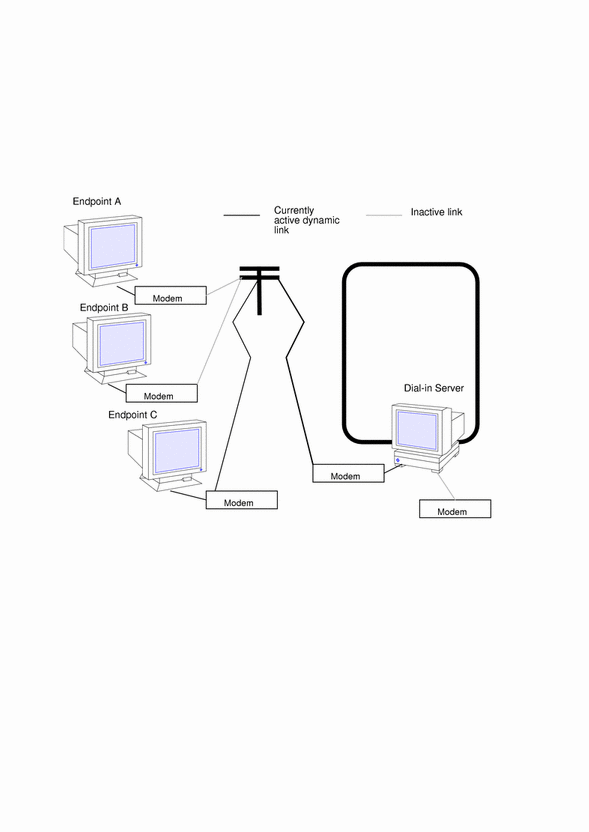Point-to-Point Configurations Supported by Solaris PPP
Solaris PPP supports four types of point-to-point configurations:
-
Host in one location connected to a host at another physical location, as shown in Figure 21-1
-
Dial-in servers with dynamic point-to-point links to remote hosts, as shown in Figure 21-2
-
Network connected to another physically distant network, as shown in Figure 21-3
-
Computers connected to a multipoint dial-in server physically attached to a distant network, as shown in Figure 21-4
These PPP links provide essentially the same type of connectivity provided by a local area network but without broadcast capability. The following sections summarize the configuration types; Chapter 22, Planning for PPP gives information for setting up each configuration type.
Two Isolated Hosts Connected by a Point-to-Point Link
PPP enables you to set up a point-to-point link to connect two standalone machines in separate locations, effectively creating a network consisting solely of these two machines. This is the simplest point-to-point configuration because it involves only the two endpoints. The generic configuration shown in Figure 21-1 also uses the host-to-host configuration.
Nomadic Machines Connected to a Dial-in Server
In the past, standard dial-up or temporary connections permitted only ASCII terminals to connect to a network. With Solaris PPP, an individual machine can become part of a physically distant network by configuring it as one endpoint of the PPP link. The advantage of this nomadic connection is particularly apparent if your network includes users who travel frequently or work from home.
Figure 21-2 shows nomadic computers, each with a point-to-point link to an endpoint system on the network. The endpoint on the network is a dial-in server.
Figure 21-2 Nomadic Computers and Dynamic Link Dial-in Server

Dial-in Server With Dynamic Point-to-Point Link
The endpoint machine on the network shown in Figure 21-2 functions as a dial-in server with dynamic point-to-point links. It is called a dial-in server because remote machines can dial in to it to reach the network. When the server receives a request to dial in from a machine, the server allocates the PPP link to the machine on an as-needed basis.
A dial-in server can communicate with the remote hosts through a dynamic point-to-point link or through a multipoint link, as explained in "Multipoint Communications Links". The dynamic point-to-point link has the advantages of point-to-point communications: RIP can run over the link, and broadcasting is enabled. Perhaps most importantly, more than one machine on the physical network can function as the dial-in server. This allows you to configure backup servers, thus enabling redundancy and easier administration. Although the machines in Figure 21-2 can directly communicate with the network endpoint, they cannot directly communicate with each other. They must pass information to each other through the dial-in server endpoint.
Two Networks Connected by Point-to-Point Link
You can use PPP to connect two separate networks through a point-to-point link, with one system on each network serving as an endpoint. These endpoints communicate through modems and phone lines, essentially in the same fashion as shown in Figure 21-1. But in this setup, the endpoints, modems, and PPP software become routers for their physical networks. Using this type of configuration scheme, you can create an internetwork with wide geographic reach.
The following figure shows two networks in different locations connected by a point-to-point link.
Figure 21-3 Two Networks Connected by a PPP Link

In this example, endpoints A and B, their modems, public telephone lines, and the PPP software act as a router between the networks. These networks might have other hosts serving as routers between physical networks. Sometimes, the host functioning as the PPP router might have an additional network interface board, thus also serving as a router for a physical network.
- © 2010, Oracle Corporation and/or its affiliates
